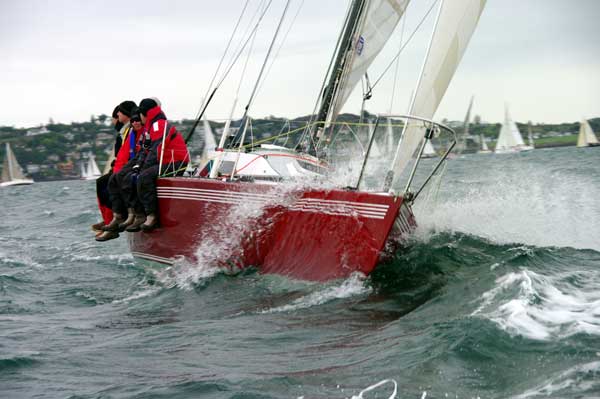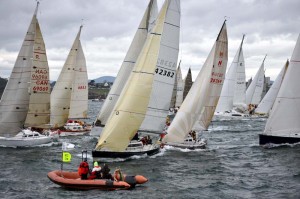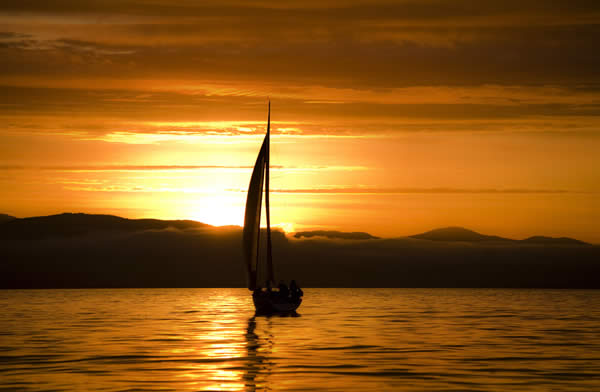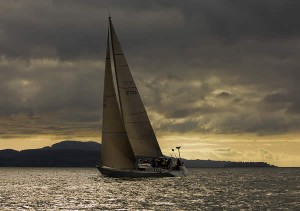[slideshow id=20]
Pegasus fighting for a spot on the line
Pegasus XIV does the 2010 Swiftsure race
The 2010 Swiftsure was many things this year but fast wasn’t one of them. It had a few moments of excitement but the word was “Well, it’s never like this…” Swiftsure normally starts with an upwind leg, the price you pay to have a good, solid downwind finish.
Oh that it were so this year.
On the other hand, we can’t say we weren’t warned. Our weather briefing Friday started with “It looks like great wind at the start with this high offshore but sometime during the day, it will move over us giving us light and variable winds.” Ugh.

Pegasus at Swiftsure. Photo by Jan Anderson
The Swiftsure
But perhaps I should back up and give some background on this most august of races. For those unfamiliar with the Swiftsure race, it is one of the “Classic” big ocean races for serious offshore, distance sailors. It starts from Vancouver Island off of the lovely city of Victoria B.C. B.C. stands for “British Columbia” but B.C. sounds better since it has a familiarity about it, even for those that don’t know it is in Canada. Victoria is simply spectacular and well worth visiting for everyone, sailor and non-sailor alike. The Canadians are wonderful, genuinely hospitable and friendly folks. At least until you say something bad about Wayne Gretzky or tell them “Curling” isn’t a sport. But if you steer clear of those thorny issues, you won’t find a better group of people. Victoria has the added benefit of one of the frequent commercial float planes possibly hitting your boat while taking off down the harbor. How cool is that when the survivors tell the story at the bar!
Swiftsure is famous the World over. Whereas the Transpac is known for days and days of tropical sailing, surfing down big ocean rollers with flying fish everywhere, the Swiftsure is renowned as an overnight jaunt in the often rough and treacherous Straits of Juan de Fuca where beer is generally served warmer than these waters. Few mistake it for a Hawaii race. But for any serious big boat racer, you really want to have your “Swiftsure” ticket punched.
This year, 2010 was the 67th running of Swiftsure. Originally designed for really big boats, as in YACHTS, the first Swiftsure races were 1-2 night events that went offshore a ways just so some of the folks hanging around the Yacht Club could say “Yeah, we went into the Pacific Ocean…boy was that nasty! I almost spilled my after dinner drink on my smoking jacket!” It became such a big deal that the Canadian Navy got involved and provided an entire ship as the turning mark, a tradition that stands to this day. I heard someone tried that with an American Navy vessel awhile back. I think the boat was sunk and the crew got to spend a few years in the brig. Maybe it’s just me but having to stay 1000 yards away is a problem if you are a mark of the course, however the Canadians have a tradition and they are sticking with it.
Somewhere along the way, boats started requiring crews to stay on the rail all night when not doing sail changes so that they might win a truly splendid pickle dish, thus was the gauntlet thrown down and the racing got serious! It took years but a few boaters realized the pain could be lessened if they only went close to the ocean, not actually setting foot in it. Hence another couple of shorter race options were added so that sailors could say they “Sailed in the Swiftsure Race” without actually sailing in the Swiftsure race.
These days, there are several courses in the Swiftsure. The longest is the classic Swiftsure out to Swiftsure bank mark to the really nifty Canadian Navy ship previously mentioned, with a total distance of 139 NM. Next is the “Cape Flattery” race that takes everyone to Neah Bay where a somewhat less auspicious navy ship awaits at the entrance of the Straits of Juan de Fuca (on the American Side) for a total length of 104 NM. The final long distance race is the Juan de Fuca Race that takes their fleet a few miles shy of the entrance to the Straits on an 80 mile jaunt where a dandy little Navy vessel is anchored. Finally, there are the 18 mile day races Saturday and Sunday. I think the Navy provides a dinghy with an Ensign at the oars for those.
For 2010, the class and division breakdowns were:
- Classic Swiftsure: 21 boats, 3 divisions
- Cape Flattery Unlimited: 13 boats, 1 division (generally bigger, faster boats)
- Cape Flattery Multihull: 8 boats, 1 division
- Cape Flattery: 56 boats, 5 divisions
- Juan de Fuca: 11 boats, 1 division
- Juan de Fuca Unlimited: 27 boats, 3 divisions
(For complete results, photos, videos, and information go to: http://www.swiftsure.org/)
Big Winds and a Battle at the Line
 The start is a few miles NE from the entrance of Victoria harbor. This year the wind was already blowing up a nasty chop with whitecaps as far as the eye could see under a gun-metal gray sky. By the time we arrived in the starting area, the wind had moderated a bit to 14-16 knots from the West, but 9 miles farther ahead near Race Passage the wind would almost certainly increase. The start was #3 jib and full mainsail weather for us on Pegasus XIV, the 37’ ultralight boat I designed and built. She is made almost entirely of carbon fabric with a bit of Kevlar and “S” glass thrown in as needed for toughness. She is really light and while fast upwind relative to her rating, she generally needs some downwind to do well.
The start is a few miles NE from the entrance of Victoria harbor. This year the wind was already blowing up a nasty chop with whitecaps as far as the eye could see under a gun-metal gray sky. By the time we arrived in the starting area, the wind had moderated a bit to 14-16 knots from the West, but 9 miles farther ahead near Race Passage the wind would almost certainly increase. The start was #3 jib and full mainsail weather for us on Pegasus XIV, the 37’ ultralight boat I designed and built. She is made almost entirely of carbon fabric with a bit of Kevlar and “S” glass thrown in as needed for toughness. She is really light and while fast upwind relative to her rating, she generally needs some downwind to do well.
The first start was at 1000 hrs. for racers going to Swiftsure Bank. 10 minutes later were the Unlimited and Multihull fleets to Cape Flattery followed another 10 minutes later by our division, also on the Cape Flattery course. We had a great start near the middle of the line with clear air and nobody close; however the huge fleet plus the over-exuberance on the part of a number of boats caused a general recall so we all had to head back for another start. Simple enough, except things got messed up with the following fleet so a postponement was called and this delayed our start for about ½ hour. Given the strong flood that was going to be on our nose about the time we transited Race Rocks, this delay could have serious consequences so we were anxious to get going.
When things got straightened out, we had another run to the line but this time we decided to look for a hole at the committee boat end. We found the gap but seemly so did everyone else in our fleet. We were in OK shape but close to swapping paint with an X-119 that was barging ahead of us without rights. Two big, hard turns slowed us down enough to clear his stern. I shot through behind him with barely a hands-breadth between us and hardened up to pinch off another boat trying to sneak in above us but we had another problem. A 40’ boat we later found had started early, was directly upwind and did not turn back to restart so we were in his lee with another boat on our lee bow. We hit the line with speed but in bad air, yet somehow we were able to hold our lane in this difficult position. It seemed to take forever but we finally worked our way into clear air and then were able to blow by the “X” boat. Not bad for a boat 2.5’ shorter than he was.
As we neared Race Passage, the wind was starting to pipe up with gusts of 24 – 26 knots so we elected to shake in a reef but during the flogging, an 18” x 12” “L” shaped tear appeared below the second reef. Left alone, it would tear from leech to luff ending the race for us so we took the main down to the second reef. There wasn’t any speed lost at the time but knowing the wind would lighten shortly, we had to come up with a plan. In the mean time, we were closing in on Race Passage. We were the 4th boat through the cut which was great since we were far smaller than most in the fleet. We were flying but beating into the wind is not our strong suit. If we could hang on this far up in the group in our weakest area, a good downwind leg where “Peggy” could stretch her legs could have us on the podium!
As we went through Race Passage, we had a crucial decision to make. We had Stig Osterberg, a great sailor and local tactical expert with us to make the hard calls. He had done this race many times before and won more than his share so if anyone could make the right call, it was him but this year was difficult because of the uncertainties of the wind. Finally, he had us head out on starboard tack 25 miles or so to the US side. Many boats went with us but many elected to tack and stay near the Canadian side. This is perhaps the single biggest decision to make in the race and it is here that the race is often won or lost. And while there are many conditions where ours was the classic tactic, this race was not shaping up to be typical.
The Wind Goes Away

Swiftsure Photo by Sean Trew
About 2 hours after rounding Race Passage, the wind started to slacken and we would have to have a plan how to fix the mainsail. We finally figured that we would wrap several loops of Kevlar line through the clews of the first and second reef, then shake the reef while SLOWLY easing the line out until all the load was still on the line but the sail shape wasn’t too badly compromised. Getting the line laced seemed to take forever but given the rough seas, staying on the boat was pretty important, too so we proceeded along until it was time to go full hoist on the main. The main was hoisted up and the line through the clews paid out until the sail wasn’t too bad all things considered. It worked and we were still in the race!
As we got to the American shore, we started playing the wind and Stig showed he really knew what he was doing. We didn’t always gain with every tack into or away from the beach but we consistently were pulling away from others that went farther in and did not play the shifts. We were among the first to report crossing Longitude 124, about 45 minutes ahead of the Canadian side boats so we were fat! It was at this point in our over-confidence that the wind started to die and we could see the Canadian boats in the distance starting to creep ahead. By 2100 hours the wind was a whisper and we were ghosting along barely moving over the bottom against the current. We had a clearing sky though for a sunset that took your breath away surrounded by forests of cedar and fir trees on mountain sides that flowed down to the water. If that scenery could be bested, it was by a nearly full moon rising in the crystalline skies of the Pacific Northwest illuminating the snow capped peaks around us.
We rounded the mark at 0104 hours Sunday, about 2 hours behind the Canadian side boats. Helplessly, we had watched them go by having made up a lot of time on us in more favorable current and wind, but we weren’t beat by a long shot. The wind was so light that the ½ oz spinnaker wouldn’t fill so we went back with the light 155% genoa. Our largest genoas were sadly to remain our only choice for the rest of the race as the wind continued to shift to the nose.
By daybreak, we were near Canada again and it seemed like we were in the midst of a lot of fast boats that had checked in from the Canadian side but it was hard to tell. The crew of Dan and Carol Benjamin, (old friends from the SF Bay Area that have

Swiftsure Photo by Sean Trew
crewed many thousands of miles on Pegasus from many years past), our regular crew members Mike Berman and Colum Tinley plus new comer but really excellent sailor Josh Greene, worked the boat hard all night with some serious “heads up” sailing playing shifts and staying in the breeze, getting us back in the race but we had a long way to go. We had no formal watch system but Dan along with Mike, Colum and Josh stayed up for much of the night doing tactics, showing how gifted a group of sailors they are. Together, their hard work and excellent strategic calls got us back in the race. Sailors like this are hard to find and worth their weight in gold!
As morning turned to afternoon, the wind freshened to gusts around 8 knots so we switched to the medium 155% genoa. As we neared the final few miles, our speed really seemed down and the boats around us were walking away from us. I looked in our aft kelp window (small Plexiglas windows at the front and back of the keel) and didn’t see anything so we continued to trim the sails but they still were faster than us. I checked for kelp another few times but nothing. After 2 hours and loosing about ½ mile, I was convinced we were dragging a vegetable salad so I got down on my knees and looked low against the hull on the kelp window and sure enough, we were dragging a big thick rope of kelp that was partly crossways to the flow. We backed down and dislodged the kelp but it was too late to reel in the other boats.
We finished the race getting 2nd in division which was pretty good since we staged a couple of “Come backs” and lost a lot to the kelp. Even more impressive was that we had beaten larger boats, boat for boat and on handicap, that should have had an advantage since the whole race was a beat. Pegasus goes upwind just fine but her handicap is very low which reflects her speed potential downwind. Sort of like a golfer that has a great short game but can’t make long drives that has to play a course with long fairways and easy putting.
I can’t say enough about the crew. It is humbling to have a crew this good since they are the ones that make it possible to do well. None of this would have happened without their effort, talent and experience. I should also say that races like this require a huge amount of planning and organization to do well. We were very fortunate to have Carol along with my wife, Linda getting everything ready with the provisions, housing and transportation, (Linda was suppose to have raced with us but had to withdraw due to illness). Without a lot of planning and preparation, a race like this can be miserable. Someone with Carol’s talent for organization in addition to being able to handle every position on the boat, is a rare find indeed.
In the end,
… a lot of boats dropped out. I don’t know the exact ratio but it seems like about half dropped out from too much wind and the other half dropped out because of too little. There were one or two man overboard incidents but thankfully no one was injured, two dismastings and a few rudders that went away. It was your typical Swiftsure in that nothing was typical.
God I can’t wait to do it again!
Dan Newland
Pegasus XIV